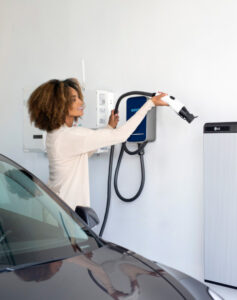High utility bills and growing anxiety about climate change might have you thinking about going solar. While the technology of the silicon photovoltaic (PV) cell has been with us since 1954 in the U.S., it didn’t take off as expected. According to the Energy Information Administration, as of 2020, only 3.7% of U.S. residences generated their electricity from solar, and commercial buildings lagged behind at only 1.6%. The good news is the same source indicates that residential solar power installation rose by 34% in 2021.
Going solar can be a significant investment.
In 2023, EnergySage stated that solar panels so far this year can range from $16,870 to $23,170 after applying the federal solar tax credit. If you need any kind of roof work done, like roof repair or to reinforce your beams to take the added weight, it could go higher. For some, the cost of buying solar and getting it installed might have you asking whether solar is right for you. There is another option and we found just the person to provide the details.
Tom Cosgrove is an energy consultant, working with Sunrun, a company that offers an innovative solar Power Purchase Agreement program. The homeowner provides the roof and Sunrun provides the panels and back-up battery. That means you only pay for the power that your home’s system produces at one fixed rate. In other words, you lease the solar panels. Of course, Sunrun also offers the option for you to purchase the panels outright through a cash transaction, or you can purchase them through a loan agreement. The Inflation Reduction Act offers a 30% tax credit when you purchase a system outright. The three options represent flexibility and affordability.
A home must qualify based on several criteria.
Cosgrove explained, “90% of my business is in leasing, and only 10% is for cash and loans. The reason that leasing is so popular is because, basically as long as your roof is in good condition and your electrical panel is up to code, and you get enough sun, there’s no upfront cost and no out of pocket expense to the homeowner.”
He added, “The first thing we do is ask the homeowner about their current electric bill, so we can see their rate plan and how much electricity they’re using. They can access that information online by going to their PG&E page and getting their annual usage, which means we can analyze 12 months of their usage data. That gives us an accurate number to work with to determine if solar makes financial sense for them.
With that information and the location of the home, Cosgrove surveys the site and starts the design that will provide him with the available sun hours, “We use satellite technology because it’s very important. Most of the homes in Sonoma and Marin Counties qualify, but there are exceptions. For example, I had a couple of people who wanted solar in Sebastopol, but we couldn’t supply panels for them because they were located in the redwoods, with too little sun. I aim for a minimum of a 100% offset of their annual usage. That means if they are using 10,000 kilowatts of electricity per year, we would want to offset in the 11,012 thousand range. The reason we do that is because it will provide enough electricity that they will avoid having a true up bill from PG&E, even if they add new appliances or an electric vehicle.”
For many of Cosgrove’s clients, their main goal is to reduce their monthly electric bill, and Sunrun guarantees a rate for the next 25 years. The rate of increase, year over year is stable at 3.5%. Current utility rates are unpredictable and have recently risen by 15.8% which is highest since August 1981. Sunrun also handles the permitting process. In fact, Sunrun takes care of everything from the design, permitting, installation, inspections, maintenance, and monitoring. Another added bonus could be the addition of battery storage to the solar panels. That way, you have enough backup energy to power your home during a power outage. You can add a battery to the Power Purchase Agreement with no upfront cost you.
An important part of Sunrun’s policy is that for any reason a homeowner can cancel the policy at any time before the actual installation date. That is important, because sometimes life gets in the way. Cosgrove shared that one of his clients cancelled last year because his stock portfolio lost $1,000,000. Feeling unsettled about the future, his client didn’t want to move ahead, so, he was able to submit a one-page cancellation, and it was done. Another advantage is that the entire system is transferrable, should you decide to sell your home during that 25 year period.
If all this sounds intriguing, here is Tom’s contact information:
Tom Cosgrove
Sunrun Solar (residential) and RW Solar (commercial)
Energy Consultant – HIS License:126733 SP
510-367-2140



